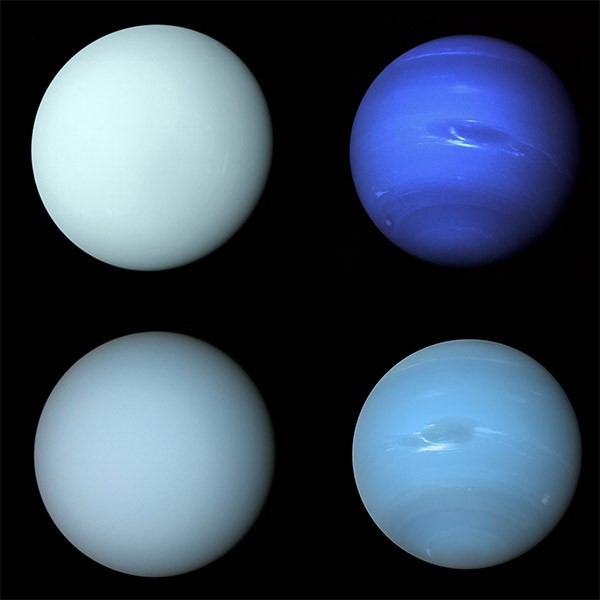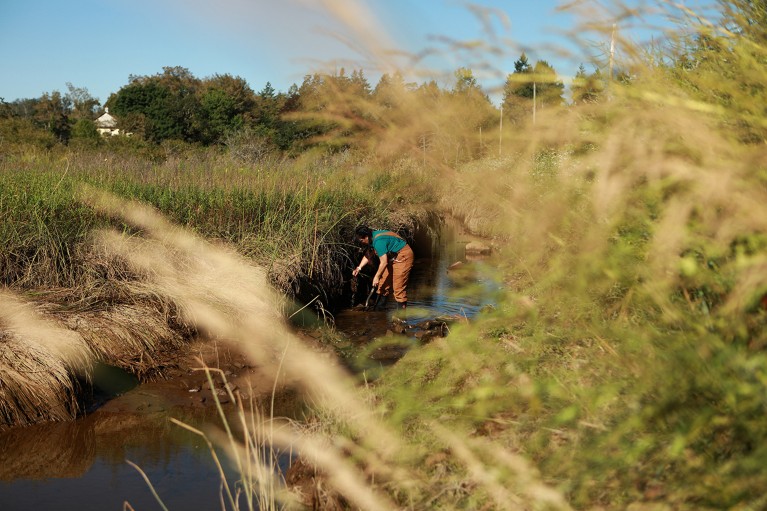Hello Nature readers, would you like to get this Briefing in your inbox free every day? Sign up here.

Uranus (left) and Neptune (right) show in the newly processed ‘true colour’ images (bottom) and the ones released shortly after the Voyager 2 flybys in 1986 and 1989 (top). (NASA/JPL-Caltech/Björn Jónsson)
Newly reprocessed images of Uranus and Neptune, taken by NASA’s Voyager 2 spacecraft in the 1980s, show that they don’t differ in colour as much as many of us think. The dark blue Neptune images we know and love had their contrast enhanced to accentuate faint, dark features. “Even though the artificially-saturated colour was known at the time amongst planetary scientists — and the images were released with captions explaining it — that distinction had become lost over time,” says planetary physicist Patrick Irwin, who contributed to the fresh look at the two planets.
Scientific American | 3 min read
Reference: Monthly Notices of the Royal Astronomical Society paper
The oldest fossil evidence of photosynthesis has been found inside tiny cyanobacteria that lived around 1.75 billion years ago, 1.2 billion years earlier than the previous record-holder. The photosynthetic structures, known as thylakoids, were found inside fossilized Navifusa majensis. Cyanobacteria are thought to have triggered the Great Oxidation Event more than 2 billion years ago, which transformed Earth’s atmosphere. “One idea is that, perhaps, they invented thylakoids at this time and this increased the quantity of oxygen on Earth,” says paleobiologist Emmanuelle Javaux, who contributed to the discovery. “Now that we’ve found very old thylakoids and that they can be preserved in very old rocks, we think that we could go further back in time and try to test this hypothesis.”
New Scientist | 3 min read
Reference: Nature paper
NASA has altered its eye-wateringly ambitious timeline for putting the next person (and the first woman) on the Moon. In 2019, US President Donald Trump set the target to 2024. But the plan — dubbed Artemis, after Apollo’s twin sister — faces big challenges. It hinges on the success of developing a heavy-lift rocket, plus the first crewed lunar lander since 1972 and a new orbiting fuel depot. NASA is now aiming for ‘boots on the Moon’ in September 2026, preceded by astronauts orbiting the satellite in 2025.
Yesterday, five NASA research payloads were on board when a spacecraft, aiming to become the first commercial mission to land on the Moon, went out of control hours after its launch.
Associated Press | 4 min read & Nature | 4 min read
Features & opinion
Table of Contents
Scientists could hugely speed up the domestication of wild crops by using tools such as CRISPR–Cas9 to make targeted genetic changes. Many wild relatives of staple crops have desirable traits such as pest- and drought-resistance that could prove immensely valuable as climate change puts stress on global agriculture. It’s a simple idea with enormous technical challenges: too little is known about wild plants’ genetics, and genetic manipulation can’t fully replicate the thousands of mutations that have fine-tuned modern domestic crops. There are also concerns that the process could exploit the knowledge of Indigenous peoples, who have cared for certain wild plants over many generations. “I am very conscious of not repeating the mistakes of the past,” says botanist Madelaine Bartlett.
Nature | 11 min read
Fieldwork can mean long stretches in shared accommodation, with little or no access to toilets — which can be even more challenging for researchers who menstruate. Ecologist Sarah Dalrymple and glaciologist Timothy Lane have put together six tips to make periods part of your planning.
• Talk openly about menstruation
• Carry period and handwashing products in group equipment
• Build in toilet stops before the fieldwork starts
• Identify someone who can be a point of contact for anyone with period-related concerns
• For longer, more-remote trips, consider discussing menstrual products and menstruation alternatives with team members
• Educate yourself and support others if you don’t menstruate
Nature | 6 min read
The more people are exposed to something, the more they perceive it to be true — regardless of its veracity. “This phenomenon pre-dates the digital age,” notes a Nature editorial. “The difference now is that online search and social media enable claims and counterclaims to be made almost endlessly.” The existence of ‘data voids’, where trustworthy information is lacking for some search terms, is part of the issue. “Genuine, lasting solutions to a problem that could be existential for democracies needs to be a partnership between search-engine providers and sources of evidence-based knowledge,” argues the editorial.
Nature | 6 min read
Reference: Nature paper
Accusations of plagiarism have long been a part of the political arsenal, writes copyright and plagiarism consultant Jonathan Bailey. But recent high-profile cases are raising fears about how it can be wielded to destroy reputations, rather than improve academic integrity. Harvard president Claudine Gay resigned last week amid plagiarism allegations that some feel were politically motivated. Billionaire Bill Ackman has since escalated his spat with the Massachusetts Institute of Technology (MIT) by saying he will sponsor a “review of the work of all current MIT faculty members”. “The fear is that this weaponization of plagiarism will result not in the public taking plagiarism more seriously, but less,” argues Bailey.
When academic Ian Bogost ran his thesis through the plagiarism-detection wringer, it took hours of work to comb through the red flags. “The result of my experiment brought me no relief, only a new anxiety,” says Bogost. A rise in “bad actors who seek to undermine educational institutions and their leaders… isn’t likely to improve academic work, but it would certainly make higher education worse.”
Plagiarism Today blog | 7 min read & The Atlantic | 10 min read (paywall)
Read more: Harvard president’s resignation amid plagiarism allegations leaves academics reeling (Nature | 6 min read)
Billionaire launches plagiarism detection effort against MIT president and all its faculty (Science | 7 min read)
Where I work

Jennifer Grenz is an Indigenous ecologist in forestry at the University of British Columbia in Vancouver, Canada.Credit: Chad Hipolito for Nature
“I had an existential crisis,” says ecologist Jennifer Grenz about the time when she realised that it’s pointless to eradicate invasive plants without holistic land-management. “Since then, my scientific journey has been about connecting my Western science to the Indigenous world view I’ve inherited as a Nlaka’pamux woman of mixed ancestry,” she says. As part of her work on Vancouver Island in Canada, Grenz consults with community-based researchers, elders and knowledge keepers. “Instead of saying, ‘How do we get rid of this invasive plant?’, we ask, ‘What do culturally important local plant species need to flourish?”.” (Nature | 3 min read)
